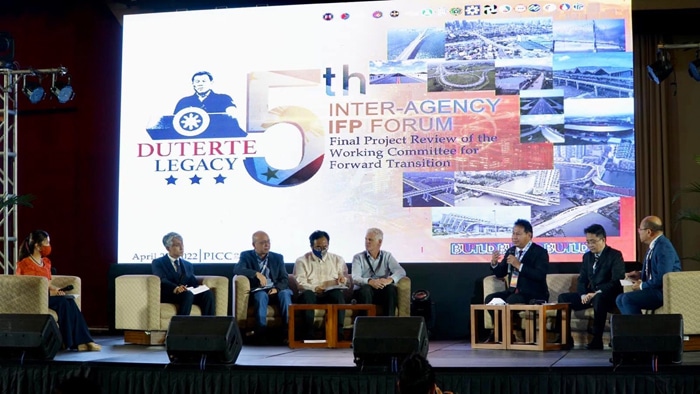It’s unlikely for anyone to ignore the numerous infrastructures built throughout the Philippines. In recent years, the Department of Public Works and Highways (DPWH) has been busy with several building projects under the “Build, Build, Build” program.

Outgoing President Rodrigo Duterte spearheaded the campaign committed to its development on July 24, 2017, during his State of the Nation Address. Since then, significant infrastructure projects have become synonymous with the government.
Meanwhile, the DPWH pledged to “make the next few years the golden age of infrastructure in the Philippines to enhance our mobility and connectivity.” They believed that economic activities become more efficient with the appropriate infrastructure.
Additionally, these projects opened new opportunities for Filipinos as they generated an estimated six million jobs for Filipinos.
While the COVID-19 pandemic posed a challenge to the growth of the Philippines, the DPWH persisted in its goal of completing several projects.
However, it refocused its goals to help the country recover from the virus.
DPWH built hundreds of quarantine isolation facilities, several modular hospitals, and nearly a hundred off-site dormitories for health workers. As a relevant government agency in the development of the country, the DPWH frequently adapts to present situations and the demand for modernization.
Boosting connectivity throughout the country
Other notable achievements of the DPWH under the “Build, Build, Build” program include bridges, expressways, terminals, and flood control projects. Although DPWH initially embarked on the program alone, it eventually found allies from the private sector who share the same vision of uplifting the Philippine economy through relevant infrastructures around the country.
Traffic in Metro Manila is a notorious problem that the government wants to solve. Many vehicles pass by particular areas to get from point to point, thus causing traffic along major roads. In response to the issue, DPWH focused extensively on constructing highways and expressways to usher in regional development and decongest highly urbanized areas.
Completed projects in NCR and nearby regions include the final section of the Tarlac-Pangasinan-La Union Expressway (TPLEX), Plaridel By-Pass Road Phase II, North Luzon Expressway (NLEX) Harbor Link Segment 10 and C3 to 10 Section, Skyway Stage 3, and Alabang-Sucat Skyway Extension.
As for the road sector, notable achievements are the completion of the Central Luzon Link Expressway, Cavite Laguna Expressway, and Manila Cavite Toll Expressway.
Presently, DPWH is fast-tracking and closely monitoring the highly-anticipated Luzon Spine Expressway Network Program that connects northern regions in the Philippines with their southern counterparts. According to the DPWH, upon the project’s completion, “travel time from Ilocos to Bicol will be reduced from 20 hours to nine hours.”
Within Metro Manila, the “Build, Build, Build” program connected several locations to ease densely populated areas in the city. Some completed projects include the Estrella-Pantaleon Bridge, Bonifacio Global City-Ortigas Center Link Road Project, and the recently completed Binondo-Intramuros Bridge.
Under the Duterte administration, the “Build, Build, Build” program constructed, widened, upgraded, rehabilitated, and strengthened 6,854 bridges throughout the country. The DPWH also turned its attention to developing new and existing roads for the benefit of the Filipinos.
These new developments not only decongested areas in the city, but also helped Filipinos gain access to necessary services like healthcare, transportation, and government agencies.
Around 40,080 kilometers of roads were constructed, maintained, widened, upgraded, and rehabilitated. These include 3,101 kms of tourism roads, 999 kms of roads leading to industries and trade corridors, 573 kms of access roads linking seaports, airports, and railway stations to enhance logistics, transport, and economic activities, and 2,712 kms of completed farm-to-market roads.
Meanwhile, the DPWH also emphasized Filipinos’ need for a fast and stable internet connection, especially since many of them transferred to a work-from-home setup due to the COVID-19 pandemic. Filipinos in the city already struggled with slow connection from the network traffic, and those living in far-flung areas faced the lack of connectivity altogether.
The DPWH’s National Broadband Program was its response to this. It aims to provide faster, efficient, and equitable broadband connectivity nationwide, particularly to those in geographically isolated and disadvantaged areas. The agency also supported the government mandate, Republic Act 10929 or the Free Internet Access in Public Places Act, by establishing 7,977 operational Wi-Fi sites in public areas nationwide.
Focusing on climate-smart infrastructures
Being an archipelago has its perks for the Philippines. However, it also opens it up to natural risks like floods, cyclones, and tsunamis. While people don’t have the power to stop these forces of nature from occurring, they can instead focus on solutions to mitigate its effects and keep the Filipinos safe.
The DPWH also prioritized climate-smart infrastructure to address common calamities, particularly flooding. Due to improper waste segregation or heavy rains, several areas in the country are prone to extreme flooding that causes heavy traffic or significant damage to existing properties. They allotted time and effort to produce standard plans for flood control programs, urban drainages, and coastal structures. Completed projects reached a total of 13,917 early in 2022.
Enhancing local tourism and economic activity
One way that the DPWH can help boost local economic activity is by focusing on tourism. Airports and ports receive the most foot traffic from local and foreign tourists. These also serve as entry and exit points for trade and commerce, hence the urgency for its improvement.
The government agency increased the capacity of existing airports and built new ones to improve the country’s air connectivity. On the other hand, ports were upgraded and modernized, along with nearby access roads to ensure reliable inter-island shipping and connectivity within their respective areas. Around 579 commercial and tourism ports and 248 airport projects were completed early in the year.
In the following years, the DPWH pledges to continue its initiative of building relevant infrastructures throughout the country to bridge the development gap between the Philippines and its neighboring countries.
As another year passes for the DPWH, it remains persistent in achieving “the golden age of Philippine infrastructures,” serving as a testament to its dedication to serving the Filipinos and putting their welfare first.





